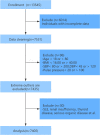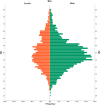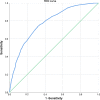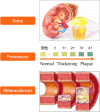Proteinuria is independently associated with carotid atherosclerosis: a multicentric study
- PMID: 34798829
- PMCID: PMC8603343
- DOI: 10.1186/s12872-021-02367-x
Proteinuria is independently associated with carotid atherosclerosis: a multicentric study
Abstract
Background and aims: Atherosclerosis is a vital cause of cardiovascular diseases. The correlation between proteinuria and atherosclerosis, however, has not been confirmed. This study aimed to assess whether there is a relationship between proteinuria and atherosclerosis.
Methods: From January 2016 to September 2020, 13,545 asymptomatic subjects from four centres in southern China underwent dipstick proteinuria testing and carotid atherosclerosis examination. Data on demography and past medical history were collected, and laboratory examinations were performed. The samples consisted of 7405 subjects (4875 males and 2530 females), excluding subjects failing to reach predefined standards and containing enough information. A multivariate logistic regression model was used to adjust the influence of traditional risk factors for atherosclerosis on the results.
Results: Compared with proteinuria-negative subjects, proteinuria-positive subjects had a higher prevalence rate of carotid atherosclerosis. The differences were statistically significant (22.6% vs. 26.7%, χ2 = 10.03, p = 0.002). After adjusting for common risk factors for atherosclerosis, age, sex, BMI, blood lipids, blood pressure, renal function, hypertensive disease, diabetes mellitus and hyperlipidaemia, proteinuria was an independent risk factor for atherosclerosis (OR = 1.191, 95% CI 1.015-1.398, p = 0.033). The Hosmer-Lemeshow test was used to test the risk prediction model of atherosclerosis, and the results showed that the model has high goodness of fit and strong independent variable prediction ability.
Conclusions: Proteinuria is independently related to carotid atherosclerosis. With the increase in proteinuria level, the risk of carotid atherosclerotic plaque increases. For patients with positive proteinuria, further examination of atherosclerosis should not be ignored.
Keywords: Atherosclerosis; Cardiovascular diseases; Epidemiology; Proteinuria; Risk factors.
© 2021. The Author(s).
Conflict of interest statement
We declare that we have no conflict of interest.
Figures





Similar articles
-
Helicobacter pylori infection selectively increases the risk for carotid atherosclerosis in young males.Atherosclerosis. 2019 Dec;291:71-77. doi: 10.1016/j.atherosclerosis.2019.10.005. Epub 2019 Oct 11. Atherosclerosis. 2019. PMID: 31704553 Free PMC article.
-
Relationship between small dense low-density lipoprotein cholesterol with carotid plaque in Chinese individuals with abnormal carotid artery intima-media thickness.BMC Cardiovasc Disord. 2021 Apr 27;21(1):216. doi: 10.1186/s12872-021-02023-4. BMC Cardiovasc Disord. 2021. PMID: 33906606 Free PMC article.
-
Association of Persistent, Incident, and Remittent Proteinuria With Stroke Risk in Patients With Diabetes Mellitus or Prediabetes Mellitus.J Am Heart Assoc. 2017 Oct 12;6(10):e006178. doi: 10.1161/JAHA.117.006178. J Am Heart Assoc. 2017. PMID: 29025745 Free PMC article.
-
Role of dipstick proteinuria for predicting cardiovascular events: a Japanese cardiovascular hospital database analysis.Heart Vessels. 2020 Sep;35(9):1256-1269. doi: 10.1007/s00380-020-01596-y. Epub 2020 Apr 4. Heart Vessels. 2020. PMID: 32248254
-
Differences in Carotid Plaques Between Symptomatic Patients With and Without Diabetes Mellitus.Arterioscler Thromb Vasc Biol. 2019 Jun;39(6):1234-1239. doi: 10.1161/ATVBAHA.118.312092. Arterioscler Thromb Vasc Biol. 2019. PMID: 31070472
Cited by
-
Kidney stone and risk of cardiovascular diseases: a cross-sectional study in the southeast of Iran.BMC Nephrol. 2025 Feb 25;26(1):101. doi: 10.1186/s12882-025-04018-1. BMC Nephrol. 2025. PMID: 40000976 Free PMC article.
-
DNA Methylation Aberrant in Atherosclerosis.Front Pharmacol. 2022 Mar 3;13:815977. doi: 10.3389/fphar.2022.815977. eCollection 2022. Front Pharmacol. 2022. PMID: 35308237 Free PMC article. Review.
References
-
- Roth GA, Abate D, Abate KH, Abay SM, Abbafati C, Abbasi N, Abbastabar H, Abd-Allah F, Abdela J, Abdelalim A, et al. Global, regional, and national age-sex-specific mortality for 282 causes of death in 195 countries and territories, 1980–2017: a systematic analysis for the Global Burden of Disease Study 2017. The Lancet. 2018;392(10159):1736–1788. doi: 10.1016/S0140-6736(18)32203-7. - DOI - PMC - PubMed
-
- Song P, Fang Z, Wang H, Cai Y, Rahimi K, Zhu Y, Fowkes FGR, Fowkes FJI, Rudan I. Global and regional prevalence, burden, and risk factors for carotid atherosclerosis: a systematic review, meta-analysis, and modelling study. Lancet Glob Health. 2020;8(5):e721–e729. doi: 10.1016/S2214-109X(20)30117-0. - DOI - PubMed
-
- Pesola GR, Argos M, Chen Y, Parvez F, Ahmed A, Hasan R, Rakibuz-Zaman M, Islam T, Eunus M, Sarwar G, et al. Dipstick proteinuria as a predictor of all-cause and cardiovascular disease mortality in Bangladesh: a prospective cohort study. Prev Med. 2015;78:72–77. doi: 10.1016/j.ypmed.2015.07.009. - DOI - PMC - PubMed
Publication types
MeSH terms
Substances
LinkOut - more resources
Full Text Sources
Medical
Miscellaneous

